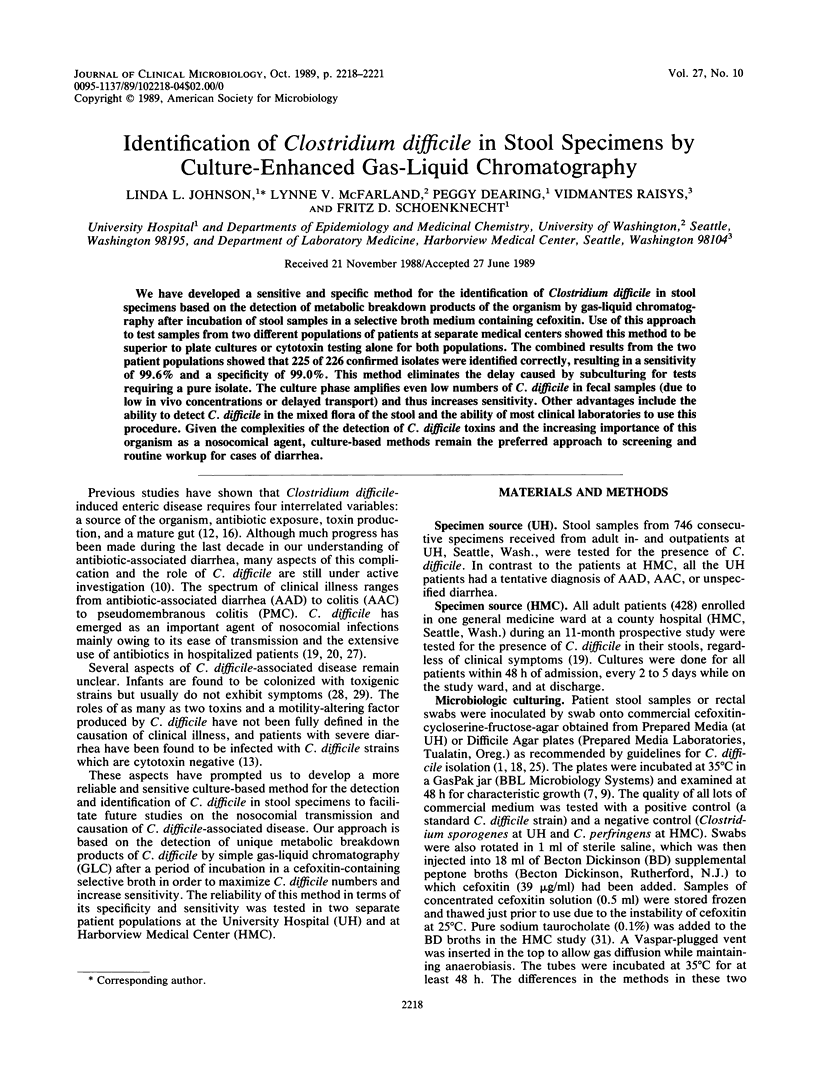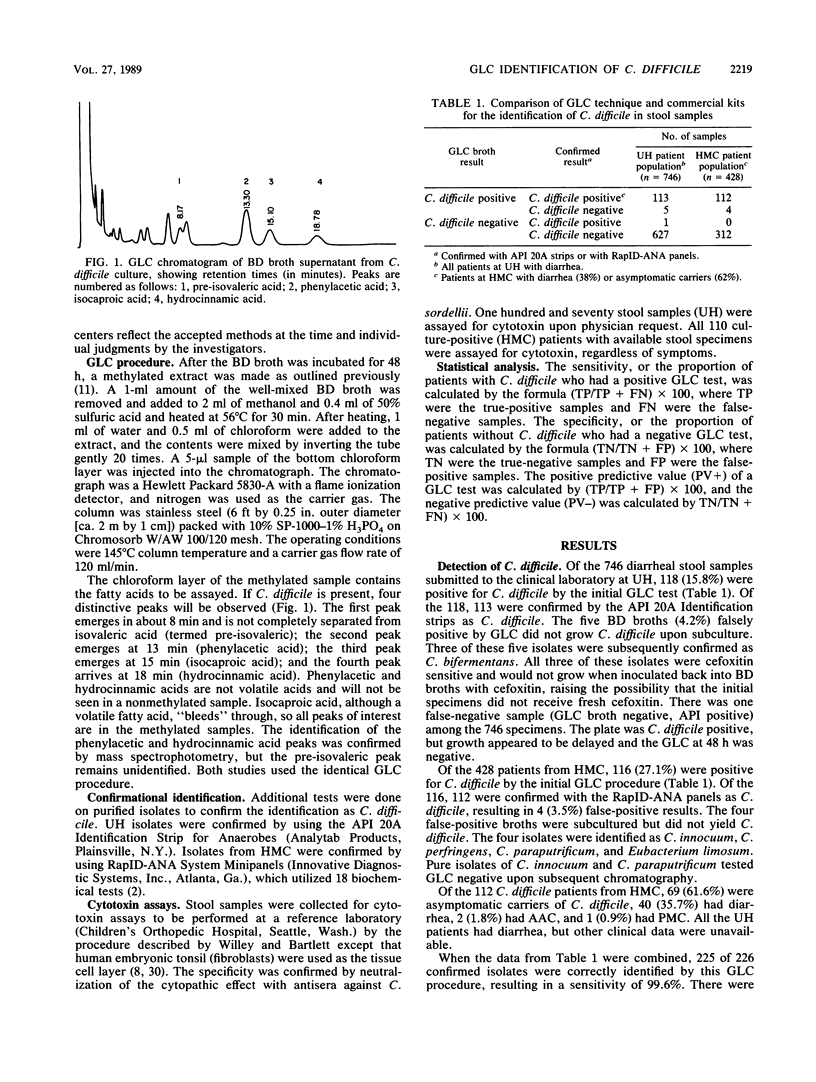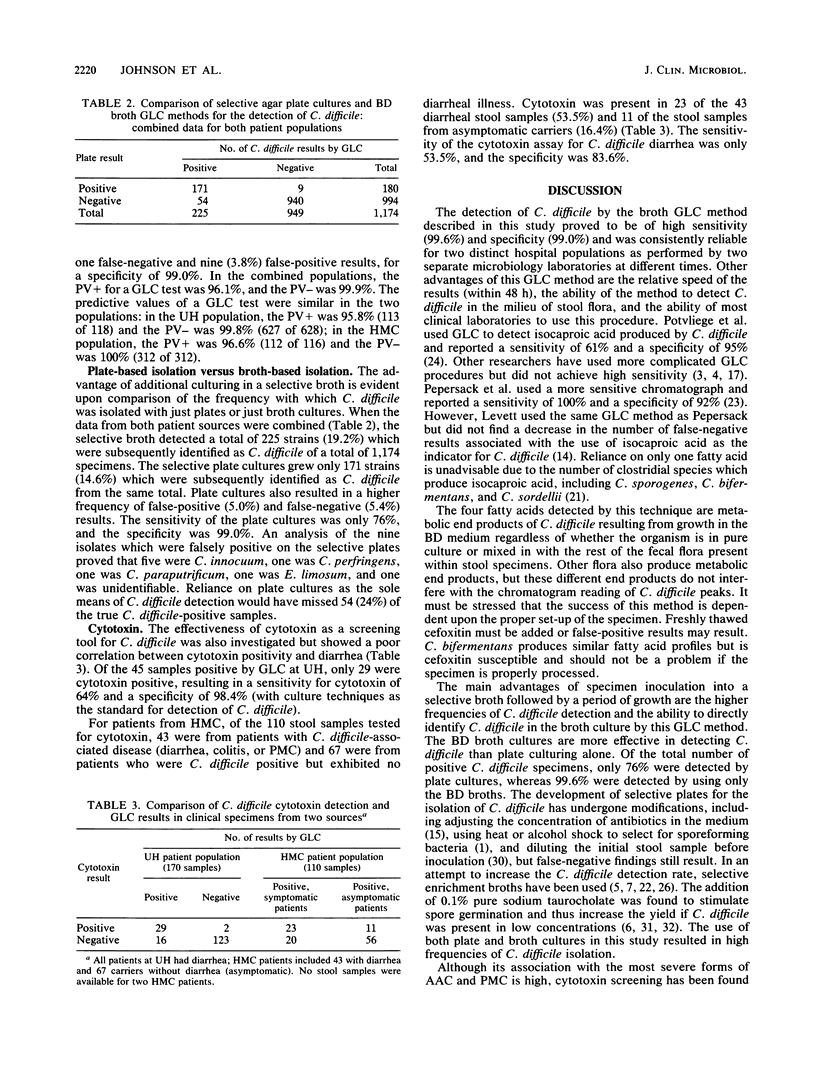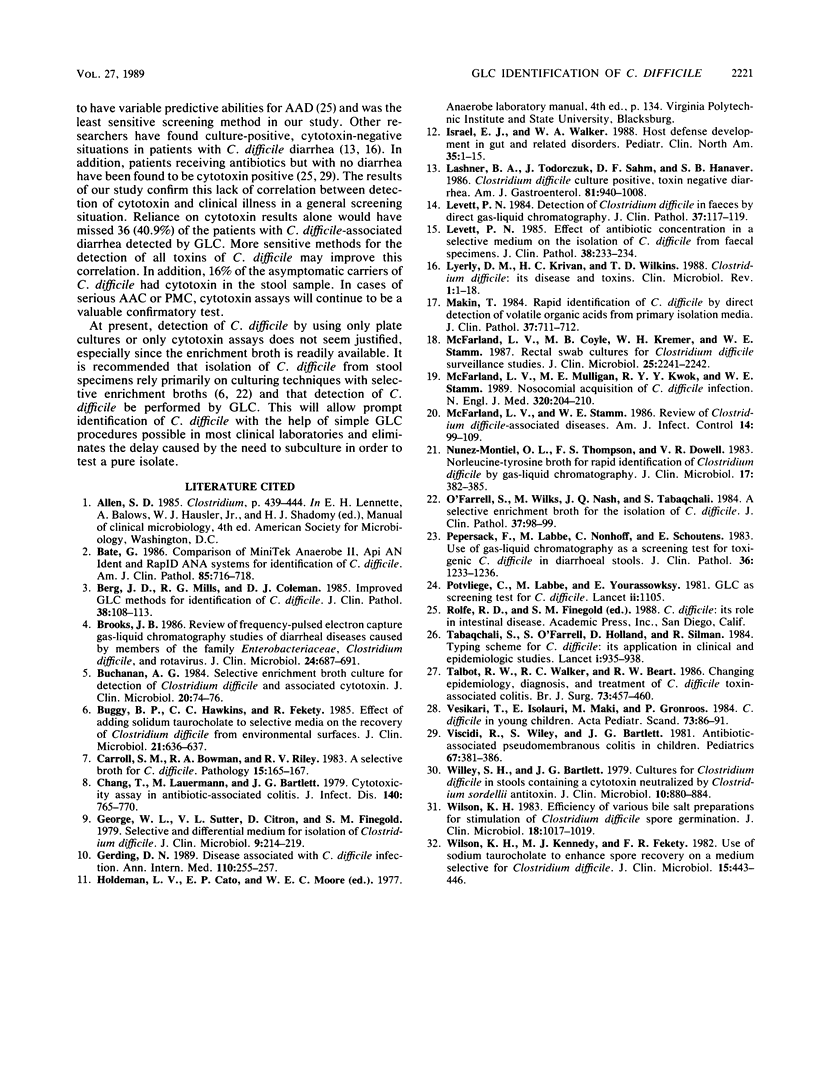Abstract
We have developed a sensitive and specific method for the identification of Clostridium difficile in stool specimens based on the detection of metabolic breakdown products of the organism by gas-liquid chromatography after incubation of stool samples in a selective broth medium containing cefoxitin. Use of this approach to test samples from two different populations of patients at separate medical centers showed this method to be superior to plate cultures or cytotoxin testing alone for both populations. The combined results from the two patient populations showed that 225 of 226 confirmed isolates were identified correctly, resulting in a sensitivity of 99.6% and a specificity of 99.0%. This method eliminates the delay caused by subculturing for tests requiring a pure isolate. The culture phase amplifies even low numbers of C. difficile in fecal samples (due to low in vivo concentrations or delayed transport) and thus increases sensitivity. Other advantages include the ability to detect C. difficile in the mixed flora of the stool and the ability of most clinical laboratories to use this procedure. Given the complexities of the detection of C. difficile toxins and the increasing importance of this organism as a nosocomial agent, culture-based methods remain the preferred approach to screening and routine workup for cases of diarrhea.
Full text
PDF



Selected References
These references are in PubMed. This may not be the complete list of references from this article.
- Bate G. Comparison of Minitek Anaerobe II, API An-Ident, and RapID ANA systems for identification of Clostridium difficile. Am J Clin Pathol. 1986 Jun;85(6):716–718. doi: 10.1093/ajcp/85.6.716. [DOI] [PubMed] [Google Scholar]
- Berg J. D., Mills R. G., Coleman D. J. Improved gas-liquid chromatography method for the identification of Clostridium difficile. J Clin Pathol. 1985 Jan;38(1):108–110. doi: 10.1136/jcp.38.1.108. [DOI] [PMC free article] [PubMed] [Google Scholar]
- Brooks J. B. Review of frequency-pulsed electron-capture gas-liquid chromatography studies of diarrheal diseases caused by members of the family Enterobacteriaceae, Clostridium difficile, and rotavirus. J Clin Microbiol. 1986 Nov;24(5):687–691. doi: 10.1128/jcm.24.5.687-691.1986. [DOI] [PMC free article] [PubMed] [Google Scholar]
- Buchanan A. G. Selective enrichment broth culture for detection of Clostridium difficile and associated cytotoxin. J Clin Microbiol. 1984 Jul;20(1):74–76. doi: 10.1128/jcm.20.1.74-76.1984. [DOI] [PMC free article] [PubMed] [Google Scholar]
- Buggy B. P., Hawkins C. C., Fekety R. Effect of adding sodium taurocholate to selective media on the recovery of Clostridium difficile from environmental surfaces. J Clin Microbiol. 1985 Apr;21(4):636–637. doi: 10.1128/jcm.21.4.636-637.1985. [DOI] [PMC free article] [PubMed] [Google Scholar]
- Carroll S. M., Bowman R. A., Riley T. V. A selective broth for Clostridium difficile. Pathology. 1983 Apr;15(2):165–167. doi: 10.3109/00313028309084706. [DOI] [PubMed] [Google Scholar]
- Chang T. W., Lauermann M., Bartlett J. G. Cytotoxicity assay in antibiotic-associated colitis. J Infect Dis. 1979 Nov;140(5):765–770. doi: 10.1093/infdis/140.5.765. [DOI] [PubMed] [Google Scholar]
- George W. L., Sutter V. L., Citron D., Finegold S. M. Selective and differential medium for isolation of Clostridium difficile. J Clin Microbiol. 1979 Feb;9(2):214–219. doi: 10.1128/jcm.9.2.214-219.1979. [DOI] [PMC free article] [PubMed] [Google Scholar]
- Gerding D. N. Disease associated with Clostridium difficile infection. Ann Intern Med. 1989 Feb 15;110(4):255–257. doi: 10.7326/0003-4819-110-4-255. [DOI] [PubMed] [Google Scholar]
- Israel E. J., Walker W. A. Host defense development in gut and related disorders. Pediatr Clin North Am. 1988 Feb;35(1):1–15. doi: 10.1016/s0031-3955(16)36396-9. [DOI] [PubMed] [Google Scholar]
- Lashner B. A., Todorczuk J., Sahm D. F., Hanauer S. B. Clostridium difficile culture-positive toxin-negative diarrhea. Am J Gastroenterol. 1986 Oct;81(10):940–943. [PubMed] [Google Scholar]
- Levett P. N. Detection of Clostridium difficile in faeces by direct gas liquid chromatography. J Clin Pathol. 1984 Feb;37(2):117–119. doi: 10.1136/jcp.37.2.117. [DOI] [PMC free article] [PubMed] [Google Scholar]
- Levett P. N. Effect of antibiotic concentration in a selective medium on the isolation of Clostridium difficile from faecal specimens. J Clin Pathol. 1985 Feb;38(2):233–234. doi: 10.1136/jcp.38.2.233. [DOI] [PMC free article] [PubMed] [Google Scholar]
- Lyerly D. M., Krivan H. C., Wilkins T. D. Clostridium difficile: its disease and toxins. Clin Microbiol Rev. 1988 Jan;1(1):1–18. doi: 10.1128/cmr.1.1.1. [DOI] [PMC free article] [PubMed] [Google Scholar]
- Makin T. Rapid identification of Clostridium difficile by direct detection of volatile organic acids from primary isolation media. J Clin Pathol. 1984 Jun;37(6):711–712. doi: 10.1136/jcp.37.6.711. [DOI] [PMC free article] [PubMed] [Google Scholar]
- McFarland L. V., Coyle M. B., Kremer W. H., Stamm W. E. Rectal swab cultures for Clostridium difficile surveillance studies. J Clin Microbiol. 1987 Nov;25(11):2241–2242. doi: 10.1128/jcm.25.11.2241-2242.1987. [DOI] [PMC free article] [PubMed] [Google Scholar]
- McFarland L. V., Mulligan M. E., Kwok R. Y., Stamm W. E. Nosocomial acquisition of Clostridium difficile infection. N Engl J Med. 1989 Jan 26;320(4):204–210. doi: 10.1056/NEJM198901263200402. [DOI] [PubMed] [Google Scholar]
- McFarland L. V., Stamm W. E. Review of Clostridium difficile-associated diseases. Am J Infect Control. 1986 Jun;14(3):99–109. doi: 10.1016/0196-6553(86)90018-0. [DOI] [PubMed] [Google Scholar]
- Nunez-Montiel O. L., Thompson F. S., Dowell V. R., Jr Norleucine-tyrosine broth for rapid identification of Clostridium difficile by gas-liquid chromatography. J Clin Microbiol. 1983 Feb;17(2):382–385. doi: 10.1128/jcm.17.2.382-385.1983. [DOI] [PMC free article] [PubMed] [Google Scholar]
- O'Farrell S., Wilks M., Nash J. Q., Tabaqchali S. A selective enrichment broth for the isolation of Clostridium difficile. J Clin Pathol. 1984 Jan;37(1):98–99. doi: 10.1136/jcp.37.1.98. [DOI] [PMC free article] [PubMed] [Google Scholar]
- Pepersack F., Labbe M., Nonhoff C., Schoutens E. Use of gas-liquid chromatography as a screening test for toxigenic Clostridium difficile in diarrhoeal stools. J Clin Pathol. 1983 Nov;36(11):1233–1236. doi: 10.1136/jcp.36.11.1233. [DOI] [PMC free article] [PubMed] [Google Scholar]
- Potvliege C., Labbé M., Yourassowsky E. Gas-liquid chromatography as screening test for Clostridium difficile. Lancet. 1981 Nov 14;2(8255):1105–1105. doi: 10.1016/s0140-6736(81)91296-4. [DOI] [PubMed] [Google Scholar]
- Tabaqchali S., Holland D., O'Farrell S., Silman R. Typing scheme for Clostridium difficile: its application in clinical and epidemiological studies. Lancet. 1984 Apr 28;1(8383):935–938. doi: 10.1016/s0140-6736(84)92392-4. [DOI] [PubMed] [Google Scholar]
- Talbot R. W., Walker R. C., Beart R. W., Jr Changing epidemiology, diagnosis, and treatment of Clostridium difficile toxin-associated colitis. Br J Surg. 1986 Jun;73(6):457–460. doi: 10.1002/bjs.1800730614. [DOI] [PubMed] [Google Scholar]
- Vesikari T., Isolauri E., Mäki M., Grönroos P. Clostridium difficile in young children. Association with antibiotic usage. Acta Paediatr Scand. 1984 Jan;73(1):86–91. doi: 10.1111/j.1651-2227.1984.tb09903.x. [DOI] [PubMed] [Google Scholar]
- Viscidi R. P., Bartlett J. G. Antibiotic-associated pseudomembranous colitis in children. Pediatrics. 1981 Mar;67(3):381–386. [PubMed] [Google Scholar]
- Willey S. H., Bartlett J. G. Cultures for Clostridium difficile in stools containing a cytotoxin neutralized by Clostridium sordellii antitoxin. J Clin Microbiol. 1979 Dec;10(6):880–884. doi: 10.1128/jcm.10.6.880-884.1979. [DOI] [PMC free article] [PubMed] [Google Scholar]
- Wilson K. H. Efficiency of various bile salt preparations for stimulation of Clostridium difficile spore germination. J Clin Microbiol. 1983 Oct;18(4):1017–1019. doi: 10.1128/jcm.18.4.1017-1019.1983. [DOI] [PMC free article] [PubMed] [Google Scholar]
- Wilson K. H., Kennedy M. J., Fekety F. R. Use of sodium taurocholate to enhance spore recovery on a medium selective for Clostridium difficile. J Clin Microbiol. 1982 Mar;15(3):443–446. doi: 10.1128/jcm.15.3.443-446.1982. [DOI] [PMC free article] [PubMed] [Google Scholar]


